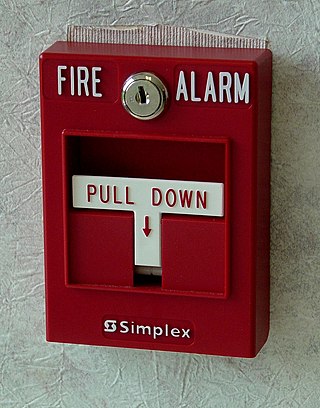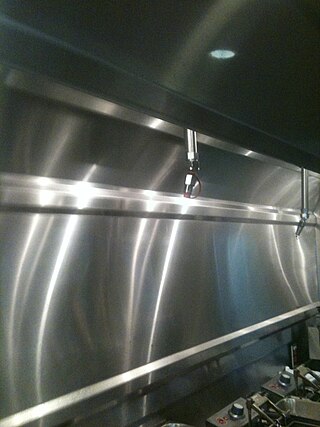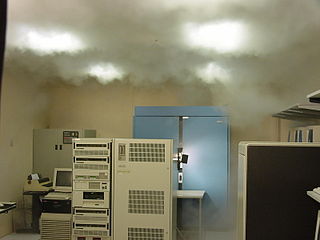
A fire sprinkler system is an active fire protection method, consisting of a water supply system providing adequate pressure and flowrate to a water distribution piping system, to which fire sprinklers are connected. Although initially used only in factories and large commercial buildings, systems for homes and small buildings are now available at a cost-effective price.

Tyco International plc was a security systems company incorporated in the Republic of Ireland, with operational headquarters in Princeton, New Jersey, United States. Tyco International was composed of two major business segments: security solutions and fire protection.

A fire alarm notification appliance is an active fire protection component of a fire alarm system. A notification appliance may use audible, visible, or other stimuli to alert the occupants of a fire or other emergency condition requiring action. Audible appliances have been in use longer than any other method of notification. Initially, all appliances were either electromechanical horns or electric bells, which would later be replaced by electronic sounders. Most of today's appliances produce sound levels between 70 and 100 decibels at three feet.

Fire safety is the set of practices intended to reduce destruction caused by fire. Fire safety measures include those that are intended to prevent the ignition of an uncontrolled fire and those that are used to limit the spread and impact of a fire.

A fire sprinkler or sprinkler head is the component of a fire sprinkler system that discharges water when the effects of a fire have been detected, such as when a predetermined temperature has been exceeded. Fire sprinklers are extensively used worldwide, with over 40 million sprinkler heads fitted each year. In buildings protected by properly designed and maintained fire sprinklers, over 99% of fires were controlled by fire sprinklers alone.
This is a glossary of firefighting equipment.

Manual fire alarm activation is the process of triggering a fire alarm through a call point, pull station, or other device. This usually causes the alarm to sound the evacuation signal for the relevant building or zone. Manual fire alarm activation requires human intervention, as distinct from automatic fire alarm activation such as that provided through the use of heat detectors and smoke detectors. It is, however, possible for call points/pull stations to be used in conjunction with automatic detection as part of the overall fire detection and alarm system. Systems in completed buildings tend to be wired in and include a control panel. Wireless activators are common during construction.
Fire protection is the study and practice of mitigating the unwanted effects of potentially destructive fires. It involves the study of the behaviour, compartmentalisation, suppression and investigation of fire and its related emergencies, as well as the research and development, production, testing and application of mitigating systems. In structures, be they land-based, offshore or even ships, the owners and operators are responsible to maintain their facilities in accordance with a design-basis that is rooted in laws, including the local building code and fire code, which are enforced by the authority having jurisdiction.

Fire suppression systems are used to extinguish, control, or in some cases, entirely prevent fires from spreading or occurring. Fire suppression systems have an incredibly large variety of applications, and as such, there are many different types of suppression systems for different applications being used today. Of these, there are some that are still in use but are no longer legal to manufacture and produce.
Active fire protection (AFP) is an integral part of fire protection. AFP is characterized by items and/or systems, which require a certain amount of motion and response in order to work, contrary to passive fire protection.

A fire alarm system is a building system designed to detect, alert occupants, and alert emergency forces of the presence of fire, smoke, carbon monoxide, or other fire-related emergencies. Fire alarm systems are required in most commercial buildings. They may include smoke detectors, heat detectors, and manual fire alarm activation devices. All components of a fire alarm system are connected to a fire alarm control panel. Fire alarm control panels are usually found in an electrical or panel room. Fire alarm systems generally use visual and audio signalization to warn the occupants of the building. Some fire alarm systems may also disable elevators, which are unsafe to use during a fire under most circumstances.
Kidde is a brand subsidiary of Carrier Global that manufactures and distributes fire detection and suppression equipment, as well as smoke and CO alarm units. Kidde is one of America's largest manufacturers of smoke alarms and fire safety products. Kidde is headquartered in Mebane, North Carolina.
Frederick Grinnell was a pioneer in fire safety and was the creator of the first practical automatic fire sprinkler.

A fire extinguisher is a handheld active fire protection device usually filled with a dry or wet chemical used to extinguish or control small fires, often in emergencies. It is not intended for use on an out-of-control fire, such as one which has reached the ceiling, endangers the user, or otherwise requires the equipment, personnel, resources or expertise of a fire brigade. Typically, a fire extinguisher consists of a hand-held cylindrical pressure vessel containing an agent that can be discharged to extinguish a fire. Fire extinguishers manufactured with non-cylindrical pressure vessels also exist but are less common.

Automatic fire suppression systems control and extinguish fires without human intervention. Examples of automatic systems include fire sprinkler system, gaseous fire suppression, and condensed aerosol fire suppression. When fires are extinguished in the early stages loss of life is minimal since 93% of all fire-related deaths occur once the fire has progressed beyond the early stages.

Ansul is a corporation headquartered in Marinette, Wisconsin that manufactures fire suppression systems, extinguishers, and administers fire training. Ansul's initial activities included production of cattle feed, refrigerants and selected specialty chemicals. The name Ansul comes from ANhydrous SULfur dioxide (SO2), which was sold to die works and fruit preservers, and later as a refrigerant. Production of fire suppression chemicals began in 1934. Virginia Chemicals, Inc. (now part of Celanese Corporation) acquired the Refrigeration and Air Conditioning Products Division of The Ansul Company in 1967, and by 1983 Ansul had discontinued all other production at the facility in Marinette. The US government is a major customer for Ansul.
Wormald is an Australian fire protection brand founded in 1889.
Autocall is a company that specializes in fire protection and customized communications equipment. The original company was founded in 1908 and was based in Shelby, Ohio. The Autocall brand became defunct in 2001 after it was incorporated into the SimplexGrinnell merger by Tyco International. On September 6, 2016, Johnson Controls and Tyco completed a merger, and Johnson Controls relaunched the Autocall brand in late 2017.
Grinnell Mechanical Products, a brand of Tyco International Ltd., manufactures grooved piping and mechanical products. Grinnell Mechanical Products specializes in mechanical, fire, HVAC, commercial, mining, institutional and industrial applications. Grinnell grooved products are used in various industries because they are historically more efficient than flanged, welded, and threaded pipe joining methods. Key product lines include grooved couplings and fittings, G-PRESS systems, strainers, stainless steel systems, copper systems, and G-MINE PVC systems. Grinnell Mechanical Products offers mechanical services used for supporting engineering and design. These include 2D and 3D drawings for the mechanical room and design suggestions and easy to follow installation drawings with legends for each pump.
Mircom Technologies Ltd. is a manufacturer and distributor of life safety and communications systems including fire detection & alarm, voice evacuation, controlled access and security solutions. The company is headquartered in Vaughan, Ontario, Canada.


















